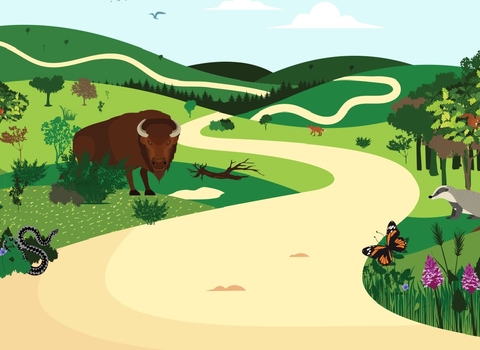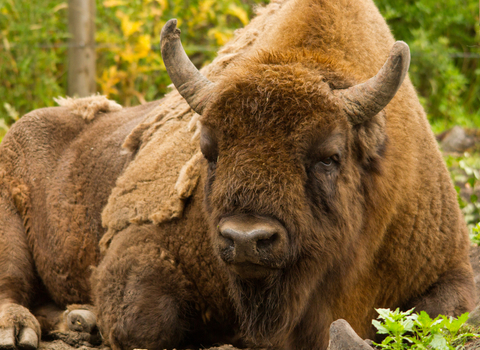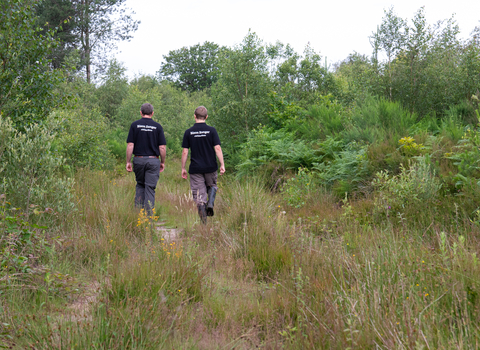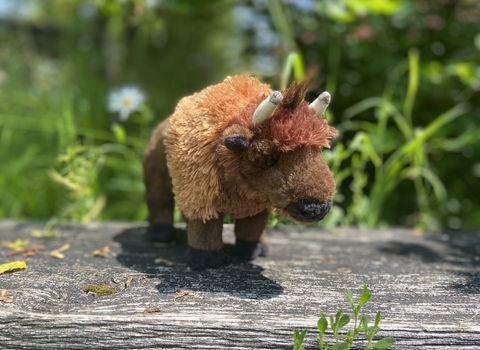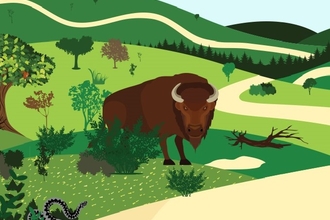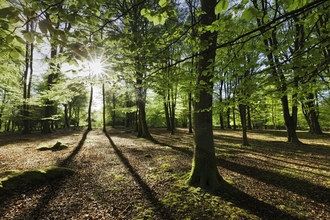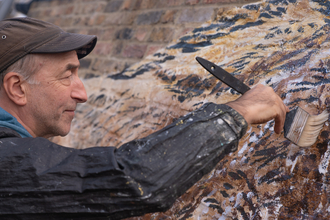COMING SOON: Four bison are due to arrive in West Blean and Thornden Woods in late spring!
In the UK, lack of woodland management is one of the eight biggest drivers of species decline.
Thanks to funds raised by players of People’s Postcode Lottery, Kent Wildlife Trust and Wildwood Trust have partnered up to show how European bison can provide a sustainable solution to woodland management in south east England.
Similar projects across Europe have proved that bison, known as ‘ecosystem engineers’, can restore the natural biodiversity of a landscape. Natural bison behaviours - grazing, dust bathing, eating bark and felling trees - enable other species to thrive.
The presence of bison at the Blean, alongside Exmoor ponies and Iron-Age pigs, will transform the woods into a lush, thriving, biodiverse environment once more and allow us to step back from hands-on management.
A key part of this project will be extensive consultation and engagement with local landowners, interest groups and residents who know and love this area.
Why did we embark on this project?
In the UK, we’re headed for increasing species extinctions in the next 10 years.
At Kent Wildlife Trust, we know that the key to enabling species to survive and thrive is to create a nature recovery network, of bigger, better quality, and more joined up habitats
Species in the UK are declining at their fastest rate for thousands of years according to the latest State of Nature report and unfortunately, human management alone is not enough to create the kinds of habitats species need.
What we need are natural solutions and this is why we’ve taken the strategy one step further, by promoting ‘Wilding’ across some of our sites in Kent. Wilding is when nature is given the tools and space it needs to recover itself and has the potential to increase the abundance of biodiversity to levels beyond what human management achieves and helps store carbon.
Where is it?
The project will take place in part of our West Blean woods nature reserve which is in one of the largest areas of ancient woodland in the UK.
The wood is ever-changing and has an ancient droveway through it that is almost a thousand years old. Before Kent Wildlife Trust bought the wood, it was managed commercially for timber production, which is why almost half of the wood is covered in plantations of non-native conifer trees.
What you need to know when going to Blean
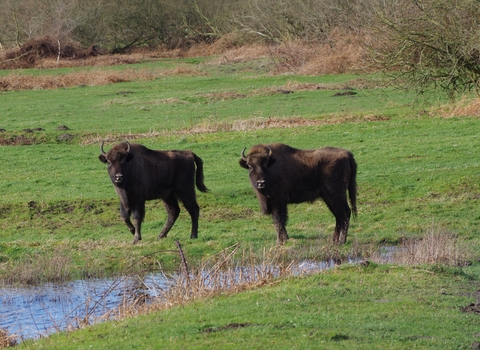
Credit: Amanda Fegan
What can you do to help?
We encourage you to learn more about wilding and how it is going to reverse the climate and nature crisis that we are currently in.
We're also really keen to learn about your current connection to the area.
Please ensure to follow @KentWildlife Trust's and @WildwoodTrust's social pages for updates on how you can get involved.
More ways to help
Frequently Asked Questions
The Project
Where is the Wilder Blean project taking place?
The project will take place in West Blean woods, near Canterbury in East Kent.
Kent Wildlife Trust owns West Blean woods which is in one of our largest nature reserves and largest areas of ancient woodland in the UK. Before we bought the wood, it was managed commercially for timber production, which is why almost half of the wood is covered in plantations of non-native conifer trees that have little value for wildlife
Why now?
Traditional conservation approaches haven’t halted the alarming loss of species diversity and abundance that we continue to witness. The climate is changing and our landscapes aren’t resilient enough to support the wildlife and communities that inhabit them. We need to adopt bolder, new approaches in conservation and we need to take action now.
Traditionally, conservation management has been a very intensive activity, relying upon significant human effort supported by machinery. But conservation approaches are changing as we recognise that nature could actually do the job better. In the UK, we’re heading towards an increasing number of species extinctions in the next 10 years. Species in the UK are declining at their fastest rate for thousands of years according to the latest State of Nature report. Human management alone is not enough to create the kinds of habitats these species need. By getting the right animals for the job (so-called ecosystem engineers) we expect to see the woodland transformed into a richer, more species abundant place for wildlife and people to enjoy.
What does this project involve?
This is the first of what we expect to be several projects which use ‘wilding’, a nature-based solution, to deliver greater diversity and abundance of wildlife on our nature reserves.
Wilding is when nature is given the freedom and space it needs to recover itself and has the potential to increase the abundance of wildlife to levels beyond what human management achieves. It also can help tackle many man-made issues such as climate change, soil degradation and flooding. On this site that means the introduction of grazing animals including bison, cows, ponies and pigs to help manage the woodland in a more natural way.
Why not concentrate on converting the conifer forest to native woodland instead of something like this?
This is a different approach to tackling the same problem.
We have been working to remove the non-native conifers for many years now. In the past, this has involved chainsaws and large pieces of machinery to remove large areas of trees at a time. This is far from ideal for wildlife. Bison can selectively fell trees and cause others to die back slowly, this is a much more natural approach which will maximise the opportunities for wildlife to flourish, creating a greater mosaic of habitats. It is also much more sustainable financially and reduces our carbon footprint. In order to maximise benefits to wildlife across a large area, we need to consider new ways of working, something we at Kent Wildlife Trust already know about from pioneering the country’s first beaver reintroduction project almost 20 years ago.
It might have been like this once, but it sounds unrealistic to go back to the stone age. There are more people and more farms now, so why now?
Wilding is an attempt to provide a natural solution to the current biodiversity and climate crisis.
This project is about wilding rather than ‘re-wilding’ - we are using this approach to see what works in the modern world. Rather than attempting to recreate a specific point in the past, we need natural solutions to the climate and biodiversity crisis we now face. This project will provide a richer natural environment and visitor experience in West Blean woods.
Is there enough space for this project, is it something you would expect in Scotland or Wales or even America?
Access to nature is fundamental to our health and wellbeing. We want to give people the opportunity to connect with nature near to where they live. We need the right tools, ecosystem engineers, in the right places to solve the climate and biodiversity crisis.
Space for nature is at a premium in our densely populated corner of the country. However, what is clear is that giving people the opportunity to connect with wildlife on their doorsteps has huge benefits from a health and wellbeing perspective, as well as a wider societal one. We need to try and squeeze as much nature as we can out of what limited space we have. A mixed-grazing project like this is an attempt to do just that.
How long will the Wilder Blean project run and how is it being funded?
The initial phase of this project will run for 3 years until May 2023 and has received separate project funding. It is, however, part of a much bigger programme of work that will form a core part of what Kent Wildlife Trust and Wildwood Trust are striving to achieve for decades to come.
Our vision to create a Wilder Kent is central to everything we do at Kent Wildlife Trust. To enable us to realise this vision we have joined forces with Wildwood Trust, a like-minded conservation charity with expertise in the captive management and breeding of native species. Our flagship project is the Wilder Blean. This is starting now, in 2020, with the first phase of the project being completed by May 2023.
Bison will be arriving in spring 2022 and before then we will be installing all the necessary infrastructure, fences and gates as well as ponds and watering holes. There will also be improvements to visitor access by way of viewing platforms and new paths to ensure the impacts on visitor experience are as amazing as the impacts for species diversity and abundance.
Will you be monitoring the Wilder Blean project and if so, how?
Yes, we have developed a comprehensive ecological monitoring programme that will be led by Kent Wildlife Trust’s Wilding Evidence Ecologist and overseen by the Trust’s Conservation Evidence Manager.
This includes monitoring multiple different layers of habitat so that we can detect change wherever it occurs. Everything from soil sampling and worm counts to collecting data on vegetation structure with drone technology. We will be monitoring several different groups of species including, invertebrates, birds and mammals. There will be many opportunities to get involved with this work. Keep an eye out for these opportunities as they arise on our website.
Has anything like this been done before?
This is a first for the UK. However, in Europe, bison are used in several different countries to manage and enhance habitats.
We have learnt a huge amount from projects of a similar nature in the Netherlands, where 4 separate bison grazing projects are currently running. In Haarlem, for example, bison have been used to restore a site for 15 years as part of a project in very close proximity to a major city. There is now free public access through the area with the bison, providing an amazing visitor experience. The habitats there have dramatically improved since the reintroduction of the bison, hence why we call them ecosystem engineers. We are frequently speaking to the teams that manage these projects and it’s a great way to gain further insight and share knowledge and ideas. Here are a few useful links to similar projects on the continent, many of the techniques used here have been used to inform this project:
https://www.bezoekdemaashorst.nl/het-oergebied/wilde-grazers
The Animals
Why bison?
Bison manage habitats in a way that no other animal can. In West Blean woods, we need to encourage more light to the woodland floor and increase the amount of deadwood to benefit native plants and animals, and this is exactly what the bison can do for us.
The way bison graze and interact with their surroundings is unique; targeting bark rather than other parts of a plant, creating ‘bull pits’ or ‘sand baths’ by dust bathing to remove parasites, removing moulting fur by rubbing against trees and due to their large size and strength, creating corridors through densely vegetated patches which in turn links up microhabitats. All these behaviours can create a healthy life cycle in woodland and create gaps in the canopy that provide a 3-dimensional habitat to the benefit of a variety of species. Without an animal like bison, these functions are missing in woodlands, and this project aims to restore those functions.
Why not start with something easier / smaller like pine marten or red squirrel?
We are in a biodiversity and climate crisis and we must act now if future generations are going to be able to experience nature in the way we have done. Bison are one of a number of possible nature-based solutions and we need to lead the way so that other projects can learn from ours.
We are already involved in many other species projects too, including beaver (another ecosystem engineer). We want to inspire others to act with big dreams such as this.
Were bison ever here before?
European bison are the closest living relative to one which used to roam the UK several thousand years ago.
They are the best chance we have of restoring the function which was lost when the earlier species went extinct.
Will the two bison currently held at Wildwood Trust be released into Blean?
No, these animals are too domesticated to be released into the wild.
Haydes and Orsk are both beloved members of the Wildwood Trust family but they are captive-bred adult animals who have never been taught how to live in the wild and so they are not the right fit for release. The bison on-site at West Blean will be sourced from free-ranging herds. Such animals will be used to foraging for themselves, living without a man-made shelter and respecting fence lines. They will also be less used to associating humans with food, which means they’re more likely to keep themselves to themselves.
What’s the difference between American bison and European bison?
Globally, there are two different types of bison alive today: European bison, and their cousins, American bison. They look quite similar however they behave differently. American bison graze on the grass of wide and open plains whereas European bison are more adapted to woodlands. In this project, we are using European bison.
Although they look quite similar, in general, European bison are a little taller than American bison, with less dense fur, and American bison are a bit stockier than European bison. They feed differently to one another due to their necks being differently set - American bison will graze on low-lying grass and leafy vegetation, whereas European bison will browse on leaves, fruit, and woody parts of plants and trees, perfect for our UK woodlands. In the past, there were more species of bison that have now gone extinct. These are the only remaining species that can do the job they do.
What about grazing animals such as cows or horses?
Cows, horses and pigs will be freely roaming within the site. Cows and horses have been used for many years although now they will be grazing across the whole site. Pigs are a new addition but will be in very low numbers (currently planned to be around 4 pigs).
We will still be using cows and horses, with bison being used in combination with these. Bison provide a missing function within the ecosystem. The way bison interact with the land is different to other grazing animals we have in the UK, like horses or cows. For instance, horses will typically only eat softer grasses, cattle will eat soft vegetation as well as twigs, but only bison will typically target and eat bark in addition to grasses and sedges. This means that the effect bison have on trees is different to cows - bison feeding can ringbark and kill select trees, leaving room for others to come through. Bison also uniquely tend to rub up against select trees to remove their thick coat of winter fur, which has a similar effect. Pigs are fantastic at churning up soil and helping seeds to grow. It is when introduced all together that these animals can be most effective, and this is what we intend to do in the project.
Wilding is about letting animals roam free and not intervening, but how will you make sure animals are safe and well if you don’t intervene?
Animal welfare is a critical factor in this project. We are using robust animal monitoring practices based on international standards of best practice.
Wilding is indeed about being as hands-off with management as possible. Nevertheless, we do have a responsibility to our animals to ensure their welfare and that they are safe. We will have rangers dedicated to the monitoring of bison. Bison will have regular health checks by our trained staff, using a standardised best practice system in place across projects in Europe. These will be used to identify any illness or health issues that might require treatment. Any problems will be closely monitored and if an animal doesn’t show any signs of getting better, appears to be in pain, or has a low score on the health check system, it can be brought in, for veterinary observation, using special corral facilities on site.
How will you deal with any problems or concerns with regards to the animals? And what if animals escape?
We have a dedicated team of staff working on the reserve area each day. Any issues will be picked up and managed according to the problem.
Kent Wildlife Trust has been safely managing conservation grazing West Blean with horses and cows for many years. Wildwood Trust staff train for animal escapes regularly and they also have extensive experience of managing bison in a variety of settings. We have robust systems in place to ensure that animals are safe, well, and unlikely to ever want to escape this beautiful area. Nonetheless, we have all appropriate risk assessments and emergency procedures in place, so that specially trained teams can be deployed quickly to deal with an emergency, in the unlikely event that one does occur. We are also upgrading all the fencing infrastructure on the site including the entire boundary fence.
What about disease transfer to other animals?
This has been carefully considered and is a very low risk however through regular checks and health screening of animals we will make sure it stays that way.
Any grazing animal will be subject to strict disease screening and quarantine before being approved for use in the project. Wildwood Trust are very experienced in completing these processes to a high-quality and following best-practice standards and will continue to do so on this project.
What does the project mean for me?
Local people are fundamental to the success of this project. We are contacting you at this very early stage so that so that we can hear any of your concerns and keep you informed of the project as it develops.
Will I still be able to use West Blean woods safely?
Yes, on the public rights of way.
The bison will be in a controlled, fenced trial area away from public footpaths. This project is all about demonstrating a woodland coming back to life and as part of this we plan to improve many of the footpaths, create new circular walks and generally increase the opportunities for people to interact with the woodland. Only once the bison are settled will we be allowing supervised access into the bison area. In the Netherlands, where bison are used more widely, people are able to walk through areas where bison are present without any issues, so long as people maintain a respectful distance.
Will I still be able to visit in the same way?
The public footpaths are not changing.
There are many footpaths crossing the site and these won’t be changing. We know the site is used by many different groups of people and we want to make sure that it continues to be safe to visit. Nothing will be changing immediately, however as the infrastructure will be changed and upgraded we want to hear from all user groups as to how this might affect them.
Will I be able to see the animals safely and if so, where?
Yes, as well as the fenced-off bison area which will have raised viewing points, the site will have free-roaming cattle and horses as it has done for many years and in addition, there will be a small number of pigs (currently planned to be around 4 pigs).
However, you may start to see these animals in areas of the woodland where you hadn’t before. As with all livestock and wild animals, you should always keep a respectful distance away and dogs should be kept on a lead so as not to cause the animals stress. These animals, whilst safe, are not pets and are here to do a job. They should never be fed by the public.
What about disabled access?
In addition to the current Wild Art Trail which will remain, we are planning to improve the surfaces of some of the paths making them more accessible to wheelchair and reduced-mobility users.
We will be building viewing towers so that visitors can look out over the bison area and we plan to make these as accessible as possible. The parking bays for blue badge holders will remain.
How will my animals in neighbouring fields be protected?
An entirely new perimeter stock fence is being installed, added to which the bison will be inside another fence within this area.
Supporting the work of our rangers, we will have a team of volunteers dedicated to carrying out regular fence checks to ensure our site always remains safe and secure.
How do I get involved?
We’ll be holding a series of meetings, pop up stands and conversations as the project gets started, to enable local priorities to be fed into our plans. Please follow Kent Wildlife Trust and Wildwood Trust social media channels and subscribe to our newsletters for updates on how you can make sure your voice is heard. Updates will be posted across both organisations’ social media platforms.
We’d love to hear from you! As the project develops there will be many ways in which you can get involved, see below for a selection of what is to come.
Get involved from home
- Perhaps this project has made you think of your own garden or patch of land? Take a look at our website for great tips on encouraging wildlife at home. If you would like more detailed advice, you can contact either our Wild about Gardens or Wilder Landscapes teams.
- If projects like this, demonstrating new, bolder approaches to restoring nature, excite you - shout about it! Now more than ever we need advocates for nature: write to your MP, sign a petition and become a member. It all helps secure a future for our wildlife and wild spaces.
Get involved when visiting the area
- Record and report your wildlife sightings (use iRecord or post them on social media and tag us).
- Report any issues you spot, that way we can fix them in a timely fashion.
- You can also help by keeping your dog on a lead and by ensuring you take litter home with you.
- Are you a regular visitor? Why not consider becoming one of our livestock or fence checking volunteers? See below.
Get involved as a Wilder Blean project volunteer
We will be needing lots of volunteer assistance as the project develops and we’ll post details of all volunteer opportunities on our website as they arise. The types of roles we’ll be recruiting volunteers for will include:
- Public-facing project guides to help explain the project.
- Fence checkers to ensure the site remains safe and secure.
- Livestock checkers to ensure the animals are well and happy.
- Wildlife footage reviewers, to ensure we don’t miss anything interesting picked up by our cameras.
- Ecological monitoring assistance to help deliver our comprehensive ecological monitoring programme.
